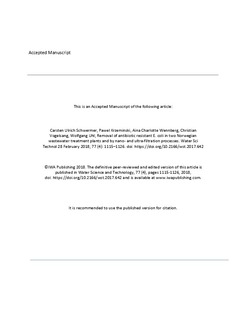Removal of antibiotic resistant E. coli in two Norwegian wastewater treatment plants and by nano- and ultra-filtration processes
Schwermer, Carsten Ulrich; Krzeminski, Pawel; Wennberg, Aina Charlotte; Vogelsang, Christian; Uhl, Wolfgang
Journal article, Peer reviewed
Accepted version
Permanent lenke
http://hdl.handle.net/11250/2599363Utgivelsesdato
2018Metadata
Vis full innførselSamlinger
- Publikasjoner fra Cristin - NIVA [2149]
- Scientific publications [1172]
Sammendrag
The effectivity of different treatment stages at two large wastewater treatment plants (WWTPs) located in Oslo, Norway, to remove antibiotic resistant Escherichia coli from municipal wastewater was investigated. The WWTPs were effective in reducing the total cultivable E. coli. The E. coli in WWTP samples were mainly resistant to ampicillin (6–27%) and trimethoprim-sulfamethoxazole (5–24%), and, to a lesser extent, tetracycline (3–14%) and ciprofloxacin (0–7%). In the first WWTP, a clear decrease in the percentage of E. coli resistant to these antibiotics was found, with the main removal occurring during physical/chemical treatment. In the second WWTP, the percentage of cultivable resistant E. coli did not display a considerable change. During laboratory-scale membrane filtration of WWTP effluents using ultrafiltration (UF) and nanofiltration (NF) membranes, all E. coli, including those resistant to antibiotics, were removed completely. The results imply that UF and NF processes are potent measures to remove antibiotic resistant bacteria (ARB) during post-treatment of WWTP effluents, thus reducing the potential spread of antibiotic resistance in the receiving aquatic environment.
